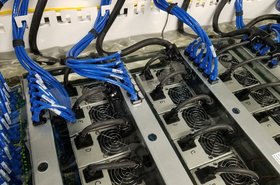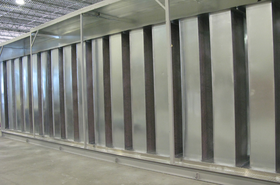The business of cooling down is heating up. The global data center liquid cooling market is expected to nearly triple in the period between 2019 and 2024, with a CAGR of almost 23 percent. Some estimates are even more robust, predicting the market size for liquid-based cooling techniques to grow from $1.5B in 2020 to $6.5B in 2027. Liquid cooling has been around for decades, why the sharp increase in popularity now? It all comes down to server rack density.
The amount of power an average rack uses has been slowly increasing over the years, where traditional data center practices could still support the steady gains. Now, however, rack density needs are beginning to expand at a rate that will soon become alarming. Between 2019 and 2020 the average rack density jumped from 7.3 kW per rack to 8.2 kW, compared to an increase of 7.2 to 7.3 from 2018 to 2019. A bump of nearly one entire kilowatt per rack is nothing to sneeze at, and the rise will only get steeper from here. Whereas about 29 percent of 2020 data centers report an average density of 10 kW or higher, by 2025 some anticipate a density of 15 to 20 kW per rack will be the norm. To put this growth in context, a decade ago data center racks used only about 2 to 5 kW on average, with 10 to 12kW per rack considered high. Now, some servers require racks where 30 to 50 kW is routine and peak around 100 kW, with such setups already representing about 5 percent of current of all racks.
The who and why of high density
Where are these high power requirements coming from? What is driving rack density increases? Colocation and hyperscale data centers are now being asked to deliver solutions for systems outside the traditional converged, hyperconverged or cloud approaches. There is a blend of new and emerging use cases forcing the issue.
One example can be found in the upswing of high-performance computing use cases in traditional industries. First, there’s the new, power-sapping technologies used in advanced modelling and data analysis, such as research performed by government, military, scientific, and academic organizations. Second, in the business world, business intelligence reporting and operational processing are all becoming massively complex, real-time transactional workloads—exemplified in the types of applications used in high frequency trading. Running 20 to 40 kW per rack for these use cases is easy to imagine. Relatedly, there’s the rise in artificial intelligence and machine learning that require significant processing and memory capabilities. Another can be found in consumer demand for high-definition videos, augmented and or virtual realities, and gaming—all early adopters of high-density architectures. Beyond established industries introducing new use cases, there are also entirely new applications, like blockchain and cryptocurrency. And this is to say nothing of the expansion of 5G networks, where organizations are starting to leverage mobile devices and IoT connections in ways that are impossible to predict.
Beyond just technical reasons, there are economic reasons for the push toward high density environments. IT departments are beginning to realize that environments that can support high density have a smaller footprint, and are more financially efficient. Simply put, more compute capability housed in less real estate maximizes the investment. The installation is faster, the setup is more scalable, and the CapEx buildout costs are cut in half. Overall, The ROI goes up while the TCO goes down without losing any compatibility or connectivity.
The demand for these workloads is ramping up, and the services will require low latency and high processing at the edge of the network, meaning the trends of today are all forcing more computing capability into smaller spaces—deployed within the walls of a traditional data center.
The cool way forward
High density racks emerging as a mainstream solution within standard data centers means traditional environments need to adapt now to accommodate new components and new ways to manage and control space and the infrastructure within it. For instance, power supply, voltage capacity, weight limitations, and containment configuration are all considerations that may or may not support high density architecture.
Greatest among the considerations is cooling. Conventional cooling methods only handle around 4kW per rack, and even advanced air cooling systems lose efficiency when racks hit the 10 to 15kW range (when 64 percent of racks require at least 10kW of power, and 33 percent of racks house 20kW or more). While there are many exciting new cooling technologies on the horizon, the consensus is that its liquid cooling’s time to shine. Although most servers are equipped with air cooling, water is 24 times more efficient than air, and can hold 3200 times as much heat.
The days of single-phase power and blown-in air are quickly entering the rear-view mirror. Are legacy data centers ready to face the future by expanding vertically instead of horizontally? Yes, the costs to retrofit a facility to high density standard are considerable—but can a forward-looking data center truly afford not to implement liquid cooling?
Data center clients will be looking for prepared, progressive data center partners whose network infrastructure is ready to grow with them. As with many things, some data centers will embrace change while others lag behind. Whether you think the glass (of cooling liquid) is half empty or half full is just a question of whether the industry shift in cooling methods will come quickly or gradually. The time is coming where, for data centers that don’t offer liquid cooling, the market demand will leave them frozen.





